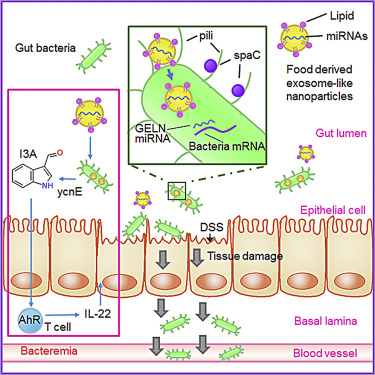华人科学家首次证实生姜外泌体miRNAs可以调节肠道菌群改善肠道健康
来源:《细胞宿主与微生物》
作者:YunTeng等
时间:2018-12-06

姜是中国人广泛使用的调料,除了调味,姜还具有一些医学功效,比如生姜可以强化米色脂肪功能,促进代谢,增加机体的胰岛素敏感性。这些功效主要靠的都是姜酚等辣味物质。而现在,姜里另一类物质的作用也被发现。
近日,来自路易斯维尔大学的张皇阁教授团队发现了姜来源的外泌体颗粒中的小RNA会影响肠道菌群,从而完善肠道的屏障功能,减轻小鼠的结肠炎。这项研究于10月25日发表在Cell Host & Microbe上。
课题组分析了不同植物来源的外泌体颗粒被小鼠食用后的组织分布,其中姜来源的外泌体主要分布在肠道中,有更多的时间去和肠道细菌接触。研究者发现,小鼠在食用一周姜外泌体颗粒后,粪便中乳酸菌和拟杆菌变多,而梭菌减少。进一步的机制研究显示,姜外泌体中的miRNA影响了乳杆菌的基因表达,一方面促进了乳杆菌的繁殖,另一方面也影响了它的代谢,产生了更多的芳烃受体的配体。芳烃受体在维持肠道的屏障功能中有重要作用,它的激活可以让肠组织产生更多的IL-22,而IL-22可以让肠道分泌更多的粘液,避免细菌粘附到肠上皮上。此外,研究者还发现姜外泌体中的另一种miRNA能抑制乳杆菌的菌毛,让乳杆菌呆在肠腔里,阻止它们进入肠粘膜上皮。
除了小鼠实验,研究人员也在人体上获得初步的验证。在58名中国江苏的志愿者中,服用姜外泌体颗粒的28名志愿者的粪便中,也发现了乳杆菌增多的现象。(来源:中国生物技术发展中心)
Plant-Derived Exosomal MicroRNAs Shape the Gut Microbiota
Abstract The gut microbiota can be altered by dietary interventions to prevent and treat various diseases. However, the mechanisms by which food products modulate commensals remain largely unknown. We demonstrate that plant-derived exosome-like nanoparticles (ELNs) are taken up by the gut microbiota and contain RNAs that alter microbiome composition and host physiology. Ginger ELNs (GELNs) are preferentially taken up by Lactobacillaceae in a GELN lipid-dependent manner and contain microRNAs that target various genes in Lactobacillus rhamnosus (LGG). Among these, GELN mdo-miR7267-3p-mediated targeting of the LGG monooxygenase ycnE yields increased indole-3-carboxaldehyde (I3A). GELN-RNAs or I3A, a ligand for aryl hydrocarbon receptor, are sufficient to induce production of IL-22, which is linked to barrier function improvement. These functions of GELN-RNAs can ameliorate mouse colitisvia IL-22-dependent mechanisms. These findings reveal how plant products and their effects on the microbiome may be used to target specific host processes to alleviate disease.
原文链接:https://www.cell.com/cell-host-microbe/fulltext/S1931-3128(18)30523-7




